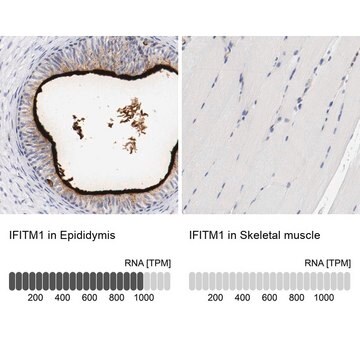MABE1125
Anti-BORIS/CTCFL Antibody, clone 4A7
clone 4A7, from human(Recombinant)
Sinónimos:
Transcriptional repressor CTCF, BORIS-like protein, Brother of the regulator of imprinted sites, Cancer/testis antigen 27, CTCF-like protein, CTCF paralog, HMG-1L1, Putative high mobility group protein 1-like 1, Putative high mobility group protein B1-li
About This Item
Productos recomendados
origen biológico
human (Recombinant)
Nivel de calidad
forma del anticuerpo
purified immunoglobulin
tipo de anticuerpo
primary antibodies
clon
4A7, monoclonal
reactividad de especies
mouse, human
técnicas
ChIP: suitable
immunocytochemistry: suitable
immunohistochemistry: suitable
western blot: suitable
isotipo
IgMκ
Nº de acceso NCBI
Nº de acceso UniProt
Condiciones de envío
wet ice
modificación del objetivo postraduccional
unmodified
Información sobre el gen
human ... CTCFL(140690)
Descripción general
Especificidad
Inmunógeno
Aplicación
Epigenetics & Nuclear Function
Chromatin Biology
Western Blotting Analysis: A representative lot detected bacterially expressed Boris N-terminal recombinant fragment, as well as endogenous Boris in mouse embryonic fibroblasts, NIH/3T3, HEK293T, and human prostate cancer cell lines, including PC3, LNCaP, and DU145 (Cheema, Z., et al. (2014). Prostate. 74(2):164-176).
Immunocytochemistry Analysis: A representative lot detected a much greater Boris immunoreactivity among human prostate cancer cell lines than the benign prostatic hyperplasia (BPH) epithelial cell line BPH-1 by both flourescent and non-fluorescent immunocytochemistry (Cheema, Z., et al. (2014). Prostate. 74(2):164-176).
Chromatin Immunoprecipitation Analysis: A representative lot detected comparable Boris occupany as CTCF at the known CTCF-targeting site (CTS) around PIM-1, while a much weaker association of Boris with another CTS, the Igf2/H19 imprinting control region (H19 ICR) was observed using chromatin preparations from human LNCaP prostate cancer cells (Courtesy of Dr. E. Klenova, University of Essex, UK).
Immunohistochemistry Analysis: A representative lot detected Boris immunoreactivity among frozen sections of prostate tumours, but not benign prostatic hyperplasia (BPH) tissues (Cheema, Z., et al. (2014). Prostate. 74(2):164-176).
Calidad
Western Blotting Analysis: 0.5 µg/mL of this antibody detected BORIS/CTCFL in 10 µg of MCF7 cell lysate.
Descripción de destino
Forma física
Almacenamiento y estabilidad
Otras notas
Cláusula de descargo de responsabilidad
¿No encuentra el producto adecuado?
Pruebe nuestro Herramienta de selección de productos.
Código de clase de almacenamiento
12 - Non Combustible Liquids
Clase de riesgo para el agua (WGK)
WGK 1
Punto de inflamabilidad (°F)
Not applicable
Punto de inflamabilidad (°C)
Not applicable
Certificados de análisis (COA)
Busque Certificados de análisis (COA) introduciendo el número de lote del producto. Los números de lote se encuentran en la etiqueta del producto después de las palabras «Lot» o «Batch»
¿Ya tiene este producto?
Encuentre la documentación para los productos que ha comprado recientemente en la Biblioteca de documentos.
Nuestro equipo de científicos tiene experiencia en todas las áreas de investigación: Ciencias de la vida, Ciencia de los materiales, Síntesis química, Cromatografía, Analítica y muchas otras.
Póngase en contacto con el Servicio técnico